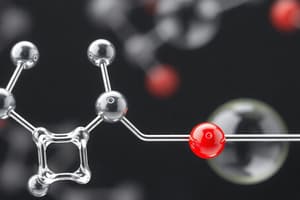Podcast
Questions and Answers
What happens to an atom when it becomes a positive ion?
What happens to an atom when it becomes a positive ion?
- It shares electrons.
- It gains electrons.
- It gains protons.
- It loses electrons. (correct)
The octet rule states that atoms prefer to have seven electrons in their outer shell.
The octet rule states that atoms prefer to have seven electrons in their outer shell.
False (B)
What is the charge of a sodium ion that has lost one electron?
What is the charge of a sodium ion that has lost one electron?
Na+
An atom that gains an electron becomes a __________ ion.
An atom that gains an electron becomes a __________ ion.
Match the following elements with the type of ion they would form when they lose electrons:
Match the following elements with the type of ion they would form when they lose electrons:
How many valence electrons does chlorine (Cl) have?
How many valence electrons does chlorine (Cl) have?
Sodium (Na) has more protons than chlorine (Cl).
Sodium (Na) has more protons than chlorine (Cl).
What type of bonding occurs when sodium and chlorine atoms interact?
What type of bonding occurs when sodium and chlorine atoms interact?
Sodium (Na) has a total of ______ protons and electrons.
Sodium (Na) has a total of ______ protons and electrons.
Match the following elements with their respective groups in the periodic table:
Match the following elements with their respective groups in the periodic table:
Which of the following substances is classified as a strong acid?
Which of the following substances is classified as a strong acid?
Salts do not conduct electricity when dissolved in water.
Salts do not conduct electricity when dissolved in water.
What is the pH range of a base?
What is the pH range of a base?
An acid typically has a _____ taste.
An acid typically has a _____ taste.
Match the following properties with their corresponding compounds:
Match the following properties with their corresponding compounds:
What is an electrolyte?
What is an electrolyte?
Electrolytic dissociation involves breaking down molecules into their constituent ions.
Electrolytic dissociation involves breaking down molecules into their constituent ions.
Provide an example of an electrolyte and its ions when dissociated.
Provide an example of an electrolyte and its ions when dissociated.
During electrolytic dissociation, a pure substance is broken down into _____ ions and _____ ions.
During electrolytic dissociation, a pure substance is broken down into _____ ions and _____ ions.
Match the following electrolytes with their dissociated ions:
Match the following electrolytes with their dissociated ions:
Which of the following is NOT a property of electrolytes?
Which of the following is NOT a property of electrolytes?
Electrolytes can dissociate into ions when dissolved in water.
Electrolytes can dissociate into ions when dissolved in water.
What ions are produced when HCl dissociates?
What ions are produced when HCl dissociates?
When an electrolyte is dissolved in water, it produces __________ and __________.
When an electrolyte is dissolved in water, it produces __________ and __________.
Match the following electrolyte properties with their descriptions:
Match the following electrolyte properties with their descriptions:
Flashcards
Valence Electrons
Valence Electrons
The outermost electrons in an atom that are involved in chemical bonding.
Electrolyte
Electrolyte
A pure substance that conducts electricity when dissolved in water.
Electrolytic Dissociation
Electrolytic Dissociation
The process of molecules breaking down into ions.
Atomic Number
Atomic Number
Signup and view all the flashcards
Cation
Cation
Signup and view all the flashcards
Ionic Bonding
Ionic Bonding
Signup and view all the flashcards
Anion
Anion
Signup and view all the flashcards
Cation
Cation
Signup and view all the flashcards
Anion
Anion
Signup and view all the flashcards
Ionic Compound
Ionic Compound
Signup and view all the flashcards
Positive Ion (Cation)
Positive Ion (Cation)
Signup and view all the flashcards
Negative Ion (Anion)
Negative Ion (Anion)
Signup and view all the flashcards
Octet Rule
Octet Rule
Signup and view all the flashcards
Outer Electron Shell
Outer Electron Shell
Signup and view all the flashcards
Electrical Conductivity of Electrolytes
Electrical Conductivity of Electrolytes
Signup and view all the flashcards
Acid
Acid
Signup and view all the flashcards
Base
Base
Signup and view all the flashcards
Contrast of Electric Charges in Electrolytes
Contrast of Electric Charges in Electrolytes
Signup and view all the flashcards
pH of an Electrolyte
pH of an Electrolyte
Signup and view all the flashcards
Salt
Salt
Signup and view all the flashcards
pH
pH
Signup and view all the flashcards
Reaction with Phenolphthalein
Reaction with Phenolphthalein
Signup and view all the flashcards



